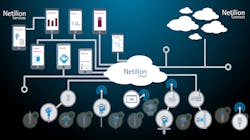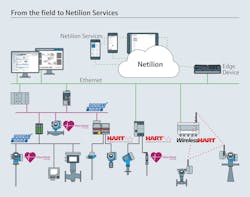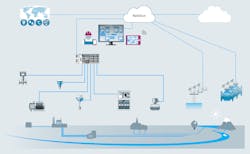How smart hardware and cloud-based software increase efficiency
As acquisitions, mergers and enterprises increasingly emerge — expanding organizations well beyond the fences of a single facility — industrial water users and producers require new ways to monitor process conditions throughout their expansive domains. Additionally, managing assets and data over these vast reaches can quickly become a challenge.
Historically, it was normal for large teams of plant personnel to carry out time-consuming tasks, like manual measurements, to ensure plants and networks were running safely. But today, industrial stakeholders can monitor operations and execute many tasks remotely, improving productivity, accuracy, efficiency and profitability.
In the modern data-centric landscape, smart instrumentation provides a wealth of diagnostic and other information, enabling plant staff to get more from their instruments than just 4-20mA primary variable measurements. This information — transmitted via digital communication protocols to central monitoring software solutions — helps plant personnel improve plant efficiency and avoid unplanned shutdowns by empowering them to implement proactive maintenance via predictive monitoring and analysis.
Delivering enhanced data and insights requires capable hardware and software
As water systems become more heavily regulated, there is a rapidly increasing list of data points to monitor. Real-time measurement and control remain vital to the health of any industrial system, but many more variables are required for reporting to regulatory agencies. Furthermore, efficiently tracking equipment diagnostic and process data, in addition to corresponding insights, can identify opportunities for treatment process optimization, making it easier to justify and get upgrade projects approved.
Obtaining and analyzing this data, in addition to performing comprehensive asset management of complex systems, is nearly impossible left to the solutions of yesteryear. But the industrial internet of things (IIoT) and connected instruments make these types of upgrades feasible for organizations of all sizes, helping them improve operational efficiency.
Smart instruments generate data
By incorporating smart instrumentation into water system designs, facility operation and optimization become much more manageable tasks. These instruments incorporate digital communication protocols, sometimes in place of — and other times on top of in the case of HART — traditional analog communication protocols, greatly increasing capabilities and value (Figure 1).
These systems regularly use flow, pressure, temperature, level and other process data to monitor and control water quality and availability, but they often discard status and diagnostic data. By passing this data by, plant personnel may miss out on opportunities to optimize, simplify and safeguard their operations.
When this data is ingested by intelligent plant analysis systems, facilities increase their ratio of proactive to reactive maintenance, thus reducing unplanned downtime, as well as equipment and human safety hazards. For example, instead of waiting for a high-temperature pump bearing failure, process data can be traced to issue an alert when anomalies are detected that would lead to this type of issue, such as steady motor temperature increase over time.
When this diagnostic data is integrated into host systems, it can be analyzed to provide advance warning of instrument or equipment failure, or troubleshooting insight in the event of a fault. Because calibration and nameplate information are also internally stored in each instrument, tracking and managing assets is easier throughout plant lifecycles.
Software creates insights
Moving process and diagnostic data into host systems is key, but especially in enterprise settings, it is difficult to make sense of data without context. With cloud-based insight generation software, the IIoT provides users with access to instrument and plant process insights so they can contextualize data and make better decisions (Figure 2).
These cloud software solutions help organizations automate tasks that were previously manual and inefficient, providing productivity gains, and continuous reporting in real time.
This empowers facilities to:
- Efficiently monitor decentralized processes through comprehensive visualization of critical variables, reducing the frequency of manual equipment inspections. Variables monitored include water quantities, limit values, levels, temperature, pressure, physicochemical quality parameters and others.
- Optimize water availability for commercial water treatment facilities using dependable forecasts of water demand based on weather and other data.
- Reduce operating costs with preemptive condition monitoring and anomaly detection, and with improved troubleshooting insights to get systems back online quickly in the event of failure.
- Access instrument and asset data independent of time and place, with web-based visualization provided via web server capability. This allows any device capable of hosting a web browser — such as a laptop, smartphone or tablet — to securely access this data.
- Analyze and visualize ratios, amounts, thresholds, time series and trends, as well as chemical balances.
This information and more are made available to plant staff in configurable dashboards, making it easy to understand operational states at a glance and make adjustments where necessary.
Results: industrial effluent monitoring
Control of waste effluent release into a sanitary sewer is a common need for industrial users, but few sites are equipped with water quality sensors to provide early indication of pollutants. Instead, composite liquid samples are typically taken at weekly or longer intervals, and then measured in the lab. This method can miss significant pollution events, each of which may adversely impact downstream wastewater treatment plants, or the environment where effluent is discharged.
A private wastewater treatment facility servicing industrial users was experiencing out-of-compliance flows into its facility, but based on lab data from its customers, it could not identify the offenders. To effectively run the business and adequately protect its own environmental discharge, the facility needed a way to single out the source of contaminants exceeding limit values.
By installing Endress+Hauser smart flow, analytical and temperature instrumentation at multiple points throughout its influent pipe network, and uploading the generated data to the Netilion cloud, it was able to securely monitor process conditions around the clock from anywhere via a web connection. The instrumentation was connected to the internet using 4G cellular gateways. With web-based visualization, reporting and alarming, the facility is now able to identify customers out of compliance, and bill them accordingly (Figure 4).
Results: water abstraction
An American multinational beverage corporation with interests in the manufacturing, retailing and marketing of nonalcoholic beverages produces concentrates and syrups, and it was looking for a way to monitor its water abstraction more closely. Of primary concern, its global team needed to maintain compliance with international regulations and evaluate the productivity of its bore holes.
By implementing smart monitoring instruments at its drilling locations, connecting these instruments to the Netilion cloud, and linking this database to local water authorities, the company ensured regulatory compliance (Figure 5).
Additionally, the insights from Netilion initiated a pump efficiency optimization project by enabling clearer access to key performance indicators. The software dashboards included these indicators, along with reports, variable limits, warnings and alarms for 22 facilities around the world.
IIoT technology sustains water processes
IIoT-based software solutions provide significant benefits for industrial water and wastewater stakeholders by enabling reliable monitoring of water quality, flow, pressure, temperature and level. And the cloud can connect all aspects of a water system, providing users with easy access to data and insights from a single source.
These capabilities enable better asset tracking of field devices, and more reliable data transfer, recording and archiving. With the high value placed on water in today’s world, IIoT technology is boosting operational efficiency, empowering users to improve their processes and bottom lines, while conserving water.
Nick Hanson is the water and wastewater industry marketing manager for Endress+Hauser USA. In this role, he is responsible for strategic market planning and industry outreach events. As part of the Endress+Hauser Global Strategic Industry Group, he acts as the voice of the U.S. market to guide solutions specific to the region. Nick has a Bachelor of Science degree in Mechanical Engineering from the University of Colorado Boulder, and over 10 years of experience in the process instrumentation and control industry.
About the Author
Nick Hanson
Water & Wastewater Industry Marketing Manager for Endress+Hauser USA
Nick Hanson is the Water & Wastewater Industry Marketing Manager for Endress+Hauser USA. In this role, he is responsible for strategic market planning and industry outreach events. As part of the Endress+Hauser Global Strategic Industry Group, he acts as the voice of the U.S. market to guide solutions specific to the region. Nick has a Bachelor of Science degree in Mechanical Engineering from the University of Colorado Boulder, and over ten years’ experience in the process instrumentation and control industry.





